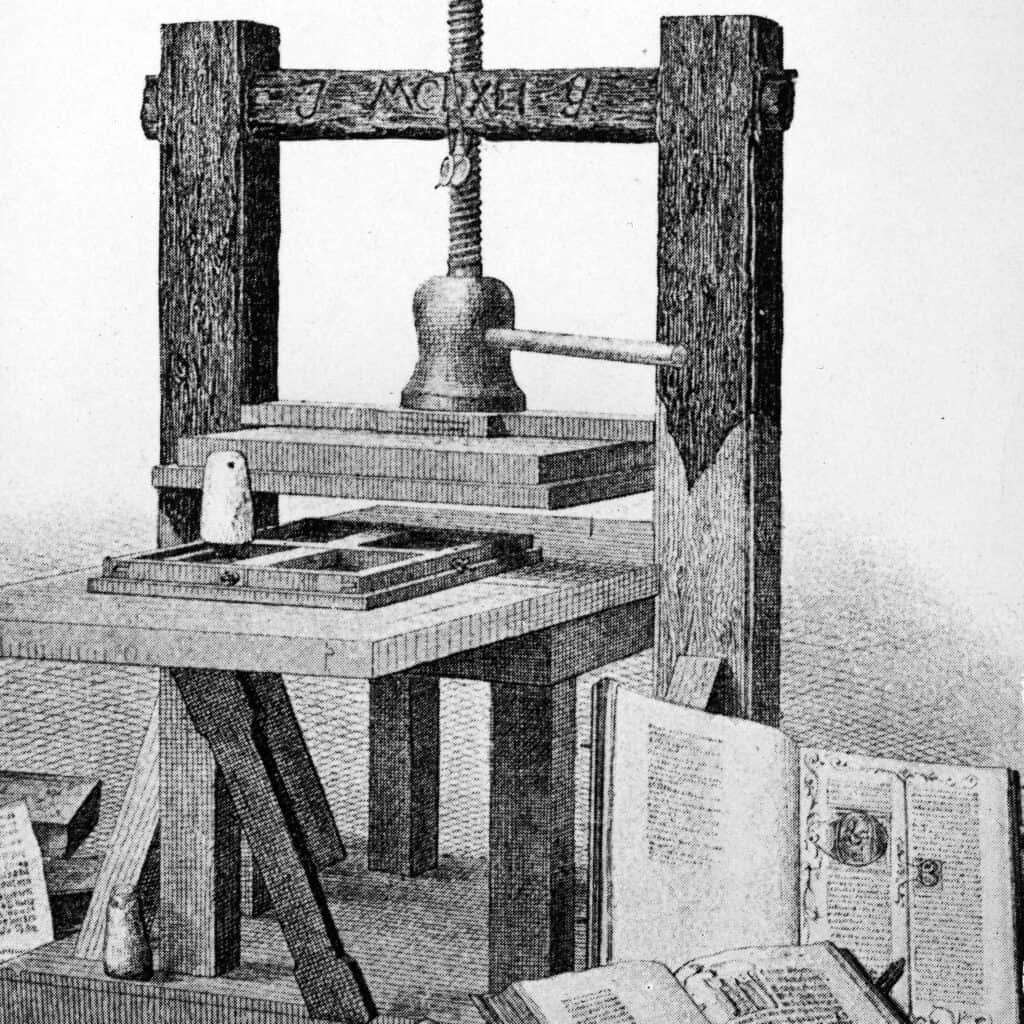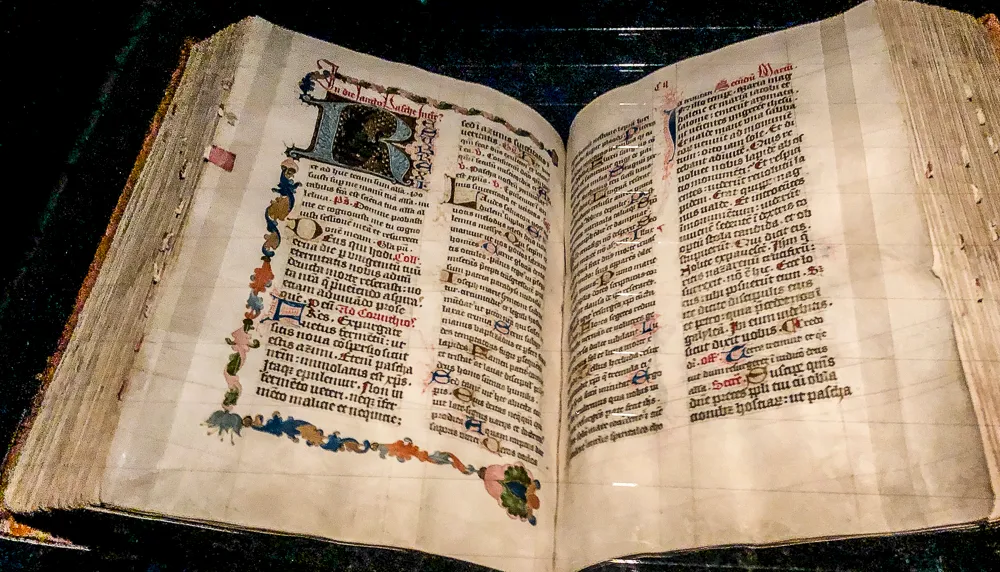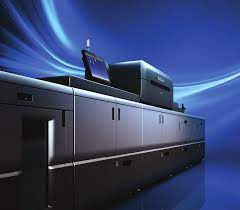In the mid-15th century, Johannes Gutenberg invented a revolutionary printing press that revolutionized communication technology and changed the world. The `Father of Print’
His name is synonymous with innovation and progress, and his invention of commercial print permanently altered the course of history.
Who was Gutenburg ?
Johannes Gutenberg was born in Mainz, Germany in the mid-1400s. He created a type of movable type which allowed for printing mass quantities of books at one time.
This invention changed communication technology and revolutionized how information was disseminated to the public.
Gutenberg’s print press was revolutionary because it allowed for the mass production of books.
This made books affordable and widely accessible to the public, which had a huge impact on society.
It enabled people to easily access knowledge that would have otherwise been difficult or impossible to obtain.

The Impact of Gutenberg’s Printing Press
Gutenberg’s invention sparked an unprecedented revolution in communications technology.
His printing press made books more accessible to the public, which helped spread knowledge and literacy across Europe. This allowed people to learn about a wide variety of topics,via Print, which in turn enabled them to better understand the world around them.
The invention of the printing press also enabled newspapers, magazines and other periodicals to be printed in mass quantities for the first time. Print and its effects on literacy in teh modern world is not to be discounted.
This opened up a wealth of possibilities for communication and media consumption. It allowed information to be disseminated quickly and efficiently, which had an immense impact on life and society.

The Printing Press – Gutenberg’s Legacy
Gutenberg’s invention was so revolutionary that it changed the world forever.
His printing press helped cultivate knowledge and literacy throughout Europe, and its effects can still be seen today.
Without his invention of Commercial Print, the world would be a completely different place.
Gutenberg’s legacy lives on in modern printing services, which continue to provide people with high-quality prints and materials.
Print and Printing is still an essential part of communication technology, and it has enabled us to share information quickly and efficiently with one another. Without Gutenberg’s pioneering invention of the printing press, we would not have the same access to knowledge that we do today.
Gutenberg’s invention of how we print stands as one of the most influential technological achievements in history, and its impacts can still be felt hundreds of years later.
Purchasing printing services is a great way to spread information quickly and efficiently, and it’s a direct result of Gutenberg’s legacy. Without his revolutionary invention, modern printing would not exist.

How Gutenberg Revolutionised Printing and the Printing Press
Prior to Gutenberg’s invention, books were printed using a labor-intensive and time-consuming technique known as block print (or block printing)
Gutenberg realized the potential of mechanizing this print process, leading him to develop the first modern moveable type printing press in Europe in 1439.
Gutenberg’s invention quickly spread throughout Europe and beyond, enabling mass production of books at an unheard rate before then.
This resulted in vast improvements in literacy and education, and increased the dissemination of knowledge.
It also had a revolutionary impact on religion, politics, and culture as books were now readily available to a much larger audience than ever before.
Timeline of Gutenberg’s Invention
1439: Gutenberg begins developing his moveable type printing press.
1450: The first complete edition of the Gutenberg Bible is printed.
1455: The Gutenberg Bible is available to the public.
1465: Johann Fust, a money lender and investor, begins printing books with moveable type in Mainz.
1467: The first printed book in England is produced using moveable type.
1476: William Caxton sets up the first printing press in England.
What was the `Gutenberg Bible’ ?
The Gutenberg Bible is a book of the Latin Vulgate, printed in Mainz, Germany, in the 1450s.
It is also known as the 42-line Bible because it was printed with movable type on a printing press and had two columns which were each 42 lines long.
This revolutionary book was the first large-scale work to be printed using moveable type technology, and is widely regarded as one of the most important Print books in history.
The Gutenberg Bible was printed in Latin, which enabled it to be read by a much larger audience than would have been possible if it had been printed in its original language.

This made the book accessible to many more people, helping to increase literacy and education across Europe at a rapid rate.
Printing Services Today
Today, Gutenberg’s invention has somewhat been replaced with digital presses and printing services that allow for highly-customised print jobs.
This has enabled businesses to quickly and efficiently produce documents, books, pamphlets, photos, promotional products, business cards and almost anything with ease and at a fraction of the cost.
From magazines and newspapers to posters and flyers, digital printing has allowed individuals and businesses to design and print their own products with high levels of precision, efficiency, vibrant colours and cost effectiveness.
With advancements in technology, the possibilities for digital printing are ever-expanding. Whether it be on paper or fabric, businesses can now easily print items tailored to their exact specifications.
From promotional items to corporate gifts, digital printing allows businesses to create high-quality products without breaking the bank.

Was he related to Steve Guttenburg, who starred in the Police Academy films ?
No, he isnt. But it was fun checking the biological timeline just in case.
A Pivotal Moment in History !
Gutenberg’s invention of the printing press was a pivotal moment in history, and its impression is still being felt today.
Without this revolutionary print technology, knowledge and information would be much harder to access.
Modern printing services have enabled us to quickly and efficiently spread information in ways that Gutenberg could have only dreamed of.
Printing is still an essential part of communication technology, and it’s all thanks to Gutenberg’s groundbreaking invention.
Without Gutenberg’s pioneering invention of the printing press, we would not be able to communicate as effectively as we do today.
His legacy lives on in modern printing services that are used throughout the world. Gutenberg revolutionized knowledge sharing and had a big impact on the course of history – and his invention of the printer still stands as one of the most influential technological achievements of all time.
References
- Deuel, T. (1962). Printing: The Story Of Gutenberg And His Press. New York, NY: Charles Scribner’s Sons.
- “Johannes Gutenberg Biography” – Biography.com Editors, Biography.com https://www.biography.com/inventor/johannes-gutenberg
- “Gutenberg Bible – New World Encyclopedia” – Sturtz, C., New World Encyclopedia https://www.newworldencyclopedia.org/entry/Gutenberg_Bible
- “The Printing Press: A Revolution in Communication History” – Powell, D., Archeolibrary
- “Gutenberg and the Printing Press” – History.com Editors, History.com https://www.history.com/topics/inventions/johannes-gutenberg-and-the-printing-press







